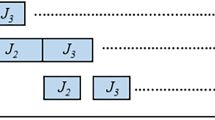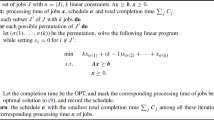Abstract
In this paper we study multiprocessor and open shop scheduling problems from several points of view. We explore a tight dependence of the polynomial solvability/intractability on the number of allowed preemptions. For an exhaustive interrelation, we address the geometry of problems by means of a novel graphical representation. We use the so-called preemption and machine-dependency graphs for preemptive multiprocessor and shop scheduling problems, respectively. In a natural manner, we call a scheduling problem acyclic if the corresponding graph is acyclic. There is a substantial interrelation between the structure of these graphs and the complexity of the problems. Acyclic scheduling problems are quite restrictive; at the same time, many of them still remain NP-hard. We believe that an exhaustive study of acyclic scheduling problems can lead to a better understanding and give a better insight of general scheduling problems.
We show that not only acyclic but also a special non-acyclic version of periodic job-shop scheduling can be solved in polynomial (linear) time. In that version, the corresponding machine dependency graph is allowed to have a special type of the so-called parti-colored cycles. We show that trivial extensions of this problem become NP-hard. Then we suggest a linear-time algorithm for the acyclic open-shop problem in which at most m−2 preemptions are allowed, where m is the number of machines. This result is also tight, as we show that if we allow one less preemption, then this strongly restricted version of the classical open-shop scheduling problem becomes NP-hard. In general, we show that very simple acyclic shop scheduling problems are NP-hard. As an example, any flow-shop problem with a single job with three operations and the rest of the jobs with a single non-zero length operation is NP-hard. We suggest linear-time approximation algorithm with the worst-case performance of \(\|\mathcal{M}\|+2\|\mathcal{J}\|\) (\(\|\mathcal{M}\|+\|\mathcal{J}\|\) , respectively) for acyclic job-shop (open-shop, respectively), where \(\|\mathcal{J}\|\) (‖ℳ‖, respectively) is the maximal job length (machine load, respectively). We show that no algorithm for scheduling acyclic job-shop can guarantee a better worst-case performance than \(\|\mathcal{M}\|+\|\mathcal{J}\|\) . We consider two special cases of the acyclic job-shop with the so-called short jobs and short operations (restricting the maximal job and operation length) and solve them optimally in linear time. We show that scheduling m identical processors with at most m−2 preemptions is NP-hard, whereas a venerable early linear-time algorithm by McNaughton yields m−1 preemptions. Another multiprocessor scheduling problem we consider is that of scheduling m unrelated processors with an additional restriction that the processing time of any job on any machine is no more than the optimal schedule makespan C *max . We show that the (2m−3)-preemptive version of this problem is polynomially solvable, whereas the (2m−4)-preemptive version becomes NP-hard. For general unrelated processors, we guarantee near-optimal (2m−3)-preemptive schedules. The makespan of such a schedule is no more than either the corresponding non-preemptive schedule makespan or max {C *max ,p max }, where C *max is the optimal (preemptive) schedule makespan and p max is the maximal job processing time.
Similar content being viewed by others
References
Gonzalez, T., & Sahni, S. (1976). Open shop scheduling to minimize finish time. Journal of the ACM, 23, 665–679.
Gonzalez, T., & Sahni, S. (1978a). Preemptive scheduling of uniform processor systems. Journal of the ACM, 25, 92–101.
Gonzalez, T., & Sahni, S. (1978b). Flow-Shop and Job-Shop schedules: complexity and approximations. Operations Research, 26, 36–52.
Hall, N. G., Lee, T. E., & Posner, M. E. (2002). The complexity of cyclic shop scheduling problems. Journal of Scheduling, 5, 307–327.
Hefetz, N., & Adiri, I. (1982). An efficient optimal algorithm for two-machines unit-time job-shop schedule-length problem. Mathematics of Operations Research, 7, 354–360.
Jackson, J. R. (1955). Scheduling a production line to minimize maximum tardiness (Research Report No. 43). Management Science Research Project, University of California, Los Angeles.
Lawler, E. L., & Labetoulle, J. (1978). On preemptive scheduling of unrelated parallel processors by linear programming. Journal of the ACM, 25, 612–619.
Lenstra, J. K., Rinnooy Kan, A. H. G., & Brucker, P. (1977). Algorithms for scheduling unrelated parallel machines. Annals of Discrete Mathematics, 1, 343–362.
Lenstra, J. K., Shmoys, D. B., & Tardos, E. (1990). Approximation algorithms for scheduling unrelated parallel machines. Mathematical Programming, 46, 259–271.
McNaughton (1959). Scheduling with deadlines and loss functions. Management Science, 6, 1–12.
Potts, C. N. (1985). Analysis of a linear programming heuristic for scheduling unrelated parallel machines. Discrete Applied Mathematics, 10, 155–164.
Shachnai, H., Tamir, T., & Woeginger, G. (2002). Minimizing makespan and preemption costs on a system of uniform machines. In Proc. 10th European symposium on algorithms.
Shchepin, E., & Vakhania, N. (2002). Little-preemptive scheduling on unrelated processors. Journal of Mathematical Modeling and Algorithms, 1, 43–56.
Shchepin, E., & Vakhania, N. (2005a). An optimal rounding gives a better approximation for scheduling unrelated machines. Operations Research Letters, 33, 127–133.
Shchepin, E., & Vakhania, N. (2005b). New tight NP-hardness of preemptive multiprocessor and open-shop scheduling. In Proceedings of 2nd multidisciplinary international conference on scheduling: Theory and applications MISTA 2005 (pp. 606–629).
Shchepin, E., & Vakhania, N. (2006). On machine dependency in shop scheduling. In Proceedings of the 9th WSEAS international conference on applied mathematics (pp. 323–331).
Author information
Authors and Affiliations
Corresponding author
Additional information
E.V. Shchepin was partially supported by the program “Algebraical and combinatorial methods of mathematical cybernetics” of the Russian Academy of Sciences.
N. Vakhania was partially supported by CONACyT grant No. 48433.
Rights and permissions
About this article
Cite this article
Shchepin, E.V., Vakhania, N. On the geometry, preemptions and complexity of multiprocessor and shop scheduling. Ann Oper Res 159, 183–213 (2008). https://doi.org/10.1007/s10479-007-0266-1
Published:
Issue Date:
DOI: https://doi.org/10.1007/s10479-007-0266-1




